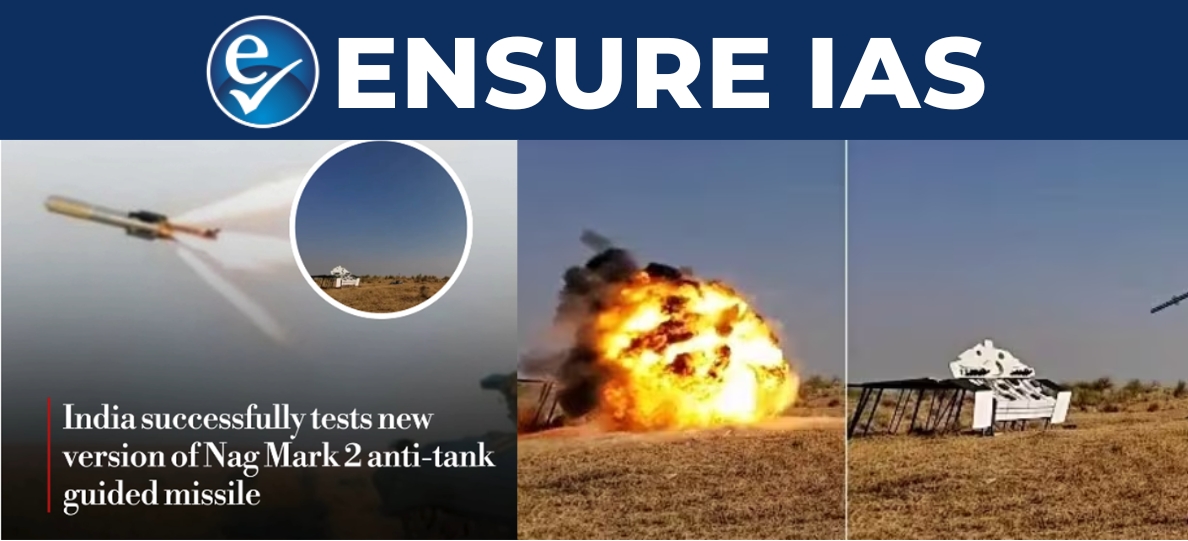- Courses
- GS Full Course 1 Year
- GS Full Course 2 Year
- GS Full Course 3 Year
- GS Full Course Till Selection
- MEP (Mains Enrichment Programme) Data, Facts
- Essay Target – 150+ Marks
- Online Program
- GS Recorded Course
- NCERT (Recorded 500+ Hours)
- Polity Recorded Course
- Geography Recorded Course
- Economy Recorded Course
- AMAC Recorded Course
- Modern India, Post Independence & World History
- Environment Recoded Course
- Governance Recoded Course
- Science & Tech. Recoded Course
- International Relations and Internal Security Recorded Course
- Disaster Management Module Course
- Ethics Recoded Course
- Current Affairs Recoded Course
- CSAT
- 5 LAYERED ARJUNA Mentorship
- Public Administration Optional
- ABOUT US
- OUR TOPPERS
- TEST SERIES
- FREE STUDY MATERIAL
- VIDEOS
- CONTACT US
India Successfully Tests Nag Mark 2 Anti-Tank Guided Missile
India Successfully Tests Nag Mark 2 Anti-Tank Guided Missile
14-01-2025

- On January 13, 2025, the Defence Research and Development Organisation (DRDO) successfully conducted field trials of the Nag Mark 2, a third-generation anti-tank guided missile (ATGM).
- The missile is developed indigenously and has advanced fire-and-forget technology.
- The trials were held at Pokhran in Rajasthan, and the missile hit all targets precisely at both maximum and minimum range, proving its accuracy and reliability.
- This achievement marks a major step in strengthening India's defence capabilities, especially in anti-tank warfare.
|
Key Points of the Nag Mark 2 Trials
- Successful Performance: The Nag Mark 2 missile hit all targets during the field trials, confirming its ability to operate at both maximum and minimum range limits.
- Precision and Reliability: The missile demonstrated exceptional precision, destroying targets with high accuracy and showcasing its dependability under field conditions.
- Fire-and-Forget Technology: The missile’s fire-and-forget capability allows the operator to lock onto the target before launch. After firing, the missile guides itself autonomously to the target, ensuring it remains effective in complex and fast-changing battle environments.
Nag Mark 2 Development
- Designed for Modern Armoured Vehicles: The Nag Mark 2 is built to neutralize modern tanks and armoured vehicles, including those protected by explosive reactive armour (ERA), making it highly effective against advanced military threats.
- Specialised in Anti-Tank Warfare: The missile is a key asset in India's anti-tank strategy, designed to enhance the country’s capabilities in modern battlefield situations, especially in border areas.
Integration with NAMICA
- NAMICA Platform: The Nag Mark 2 is integrated with the Nag Missile Carrier (NAMICA) Version 2, which is a vehicle designed to launch the missile. The successful testing of both the missile and the carrier system shows the complete weapon system is ready for use.
- Improved Mobility and Flexibility: The NAMICA version 2 allows the missile to be launched from a mobile platform, improving its adaptability and effectiveness on the battlefield.
Strategic Importance
- Strengthening India's Defence: The successful trials of the Nag Mark 2 missile help India enhance its anti-tank capabilities. It is an important tool for the Indian Army to counter armoured threats along its borders.
- Self-Reliance in Defence: This success aligns with India's goal of achieving self-reliance in defence manufacturing, reducing dependency on foreign weapons and boosting local defence production under the Atmanirbhar Bharat (Self-Reliant India) initiative.
Key Features of the Nag Mark 2
- Fire-and-Forget Technology: This technology allows the missile to be launched with the target locked in, and after launch, it guides itself to the target, requiring minimal input from the operator.
- Versatility: The Nag Mark 2 is capable of targeting and destroying modern armoured vehicles, including tanks with explosive reactive armour (ERA), enhancing its effectiveness in varied combat situations.
- Platform Compatibility: The missile can be launched from the Nag Missile Carrier (NAMICA), which improves mobility and ensures that it can be deployed quickly and efficiently in the battlefield.
- Precision Targeting: With its advanced guidance system, the missile strikes targets accurately, making it a reliable weapon for neutralising enemy armoured vehicles.
Conclusion
The successful trials of the Nag Mark 2 missile mark a significant milestone in India’s military capabilities. The missile's advanced fire-and-forget technology, precision, and ability to neutralize modern armoured vehicles make it a powerful asset for the Indian Army. Its successful integration with the NAMICA platform adds to its versatility. The achievement also highlights India’s growing self-reliance in defence manufacturing, supporting the Atmanirbhar Bharat initiative and reducing dependence on foreign defence systems.
|
Also Read |
|
| FREE NIOS Books | |




